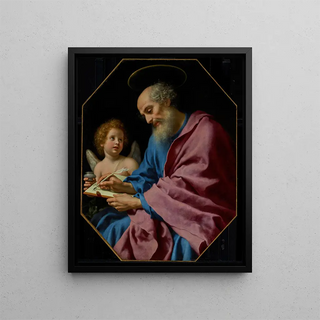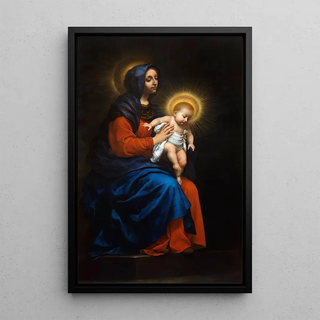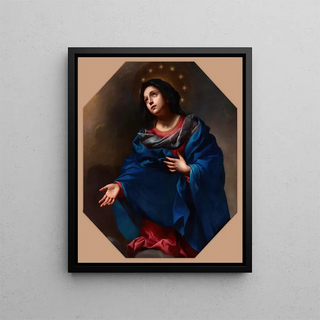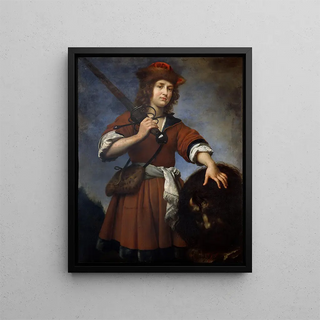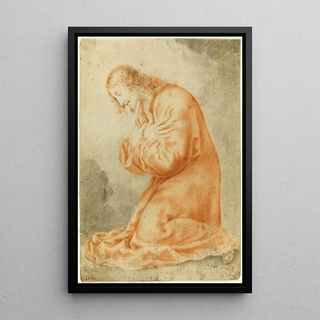Buy a Carlo Dolci art print: sacred art, perfection of detail, and spiritual emotion for a noble and luminous decoration.
Discover art prints of paintings by Carlo Dolci (1616–1686), a Florentine painter of the Italian Baroque, renowned for the delicacy of his brushwork, the purity of his religious compositions, and the emotional depth of his faces.
His works, imbued with fervor and refinement, embody the spirituality and idealized beauty of 17th-century Florentine painting.
Our art prints in museum quality, on canvas or art paper, capture the softness of his flesh tones, the brilliance of his colors, and the mystical light of his compositions.
Choosing an art print of Dolci means inviting into your home the serenity, beauty, and spirituality of Italian baroque.
Carlo Dolci: the Florentine master of devotion
Born in Florence in 1616, Carlo Dolci was trained from childhood in the workshop of Jacopo Vignali, where he distinguished himself by his meticulousness and exceptional sensitivity.
Endowed with deep faith, he dedicates his entire career to religious painting, approached with a sincerity and precision rarely matched.
His sorrowful Virgins, meditative Christ and ecstatic saints convey an intimate emotion, a silent spirituality that transcends technique.
Dolci avoids the excesses of dramatic baroque to develop a more introspective, pure, and luminous style, where each face becomes a symbol of grace and contemplation.
Appreciated by the great Florentine patrons and the princely families of Europe, he became a model of pictorial excellence in the second half of the 17th century.
He died in Florence in 1686, recognized as one of the most refined religious painters of his time.
A style between spiritual realism and an ideal of beauty
Carlo Dolci's style is characterized by a precise drawing, a rich and luminous palette, and a contained emotional expression.
Each painting is executed with extreme care, to give the illusion of an almost supernatural perfection.
His balanced palette — celestial blues, warm golds, deep reds, and luminous whites — creates lighting effects of remarkable purity.
His faces, imbued with softness and serenity, reflect the piety and humanity of his subjects.
At Dolci's, beauty is never ostentatious: it is calm, meditative, transcendent.
He embodies the meeting between the technical rigor of Florentine realism and the mystical grace of spiritual baroque.
Refined and soothing art prints for elegant decor
Art prints of Carlo Dolci fit perfectly into classic, artistic, or contemporary interiors, where they bring light, calm, and depth.
They captivate with their nobility, purity, and silent emotion.
-
In a living room, they create a solemn and harmonious atmosphere.
-
In a bedroom, they inspire peace and contemplation.
-
In a office or a library, they evoke wisdom and spiritual beauty.
Our museum-quality prints guarantee the finesse of strokes, the richness of nuances, and the brightness of the original painting.
Hanging an art print of Dolci is to offer your decor a touch of sacredness, beauty, and Italian timelessness.
FAQ – About Carlo Dolci
When was Carlo Dolci born?
In 1616, in Florence, Italy.
What is his artistic style?
A spiritual baroque, refined and luminous, centered on divine beauty and perfection of detail.
Why is he famous?
For his religious portraits filled with emotion and his technique of exceptional precision.
What are his favorite themes?
The Virgin Mary, Christ, saints, devotion, and celestial light.
What is his color palette?
Rich and luminous tones: sky blue, warm gold, deep red, and pure white.
Where can you admire his works?
At the Uffizi Gallery (Florence), at the Louvre, at the Prado Museum, and at the National Gallery in London.
Top 5 Carlo Dolci paintings
-
The Virgin in prayer (1640) – Purity and inner light.
-
Saint Catherine of Siena (1660) – Devotion and mystical gentleness.
-
The Blessing Christ (1653) – Perfection of detail and divine serenity.
-
The Angel of the Annunciation (1648) – Lightness and spiritual brilliance.
-
The Martyrdom of Saint Andrew (1645) – Intensity and deep faith.
Why buy a Carlo Dolci art print?
Choosing a Carlo Dolci art print means bringing light, faith, and Italian beauty into your home.
His works, imbued with contemplation and grace, create a noble and soothing atmosphere.
Our faithful museum-quality art prints restore the subtlety of colors, the finesse of the brushstroke, and the luminosity of his sacred portraits.
In a living room, they inspire calm and admiration.
In a bedroom, they spread purity and serenity.
In a professional space, they reflect refinement and cultural depth.
Each art print becomes a tribute to spiritual beauty, technical perfection, and the light of Florentine baroque.
Conclusion: the sacred light of Florentine baroque
The art prints of Carlo Dolci available on artemlegrand.com celebrate the spirituality, perfection, and purity of 17th-century Italian painting.
They remind us that beauty can be both technical and spiritual, emotional and divine.
Thanks to our high-definition art prints, every gaze, every drape, and every halo regains its original brilliance.
With Dolci, your decor becomes a reflection of the grace, light, and fervor of Italian baroque.




